Yellow leaves on sunflower plants are a common sight. I am always amazed at how tough sunflowers are. However, sighting yellow or brown leaves is common.
Sunflowers or Helianthus annuus are easy to grow and provide bright, bold flowers. They are mostly grown for their tough flowers and sunflower seeds.
Sunflowers are part of the Asteraceae family and are herbaceous annual plants according to Palomar College.
Table of Contents
Why Sunflower Leaves are Turning Yellow
Sunflower leaves turn yellow due to under or over-fertilization or overwatering. Too much sun or heat, or pests can also cause yellow leaves as well as fungal diseases. Lastly, sunflower leaves turn yellow when their flowering cycle leaves.
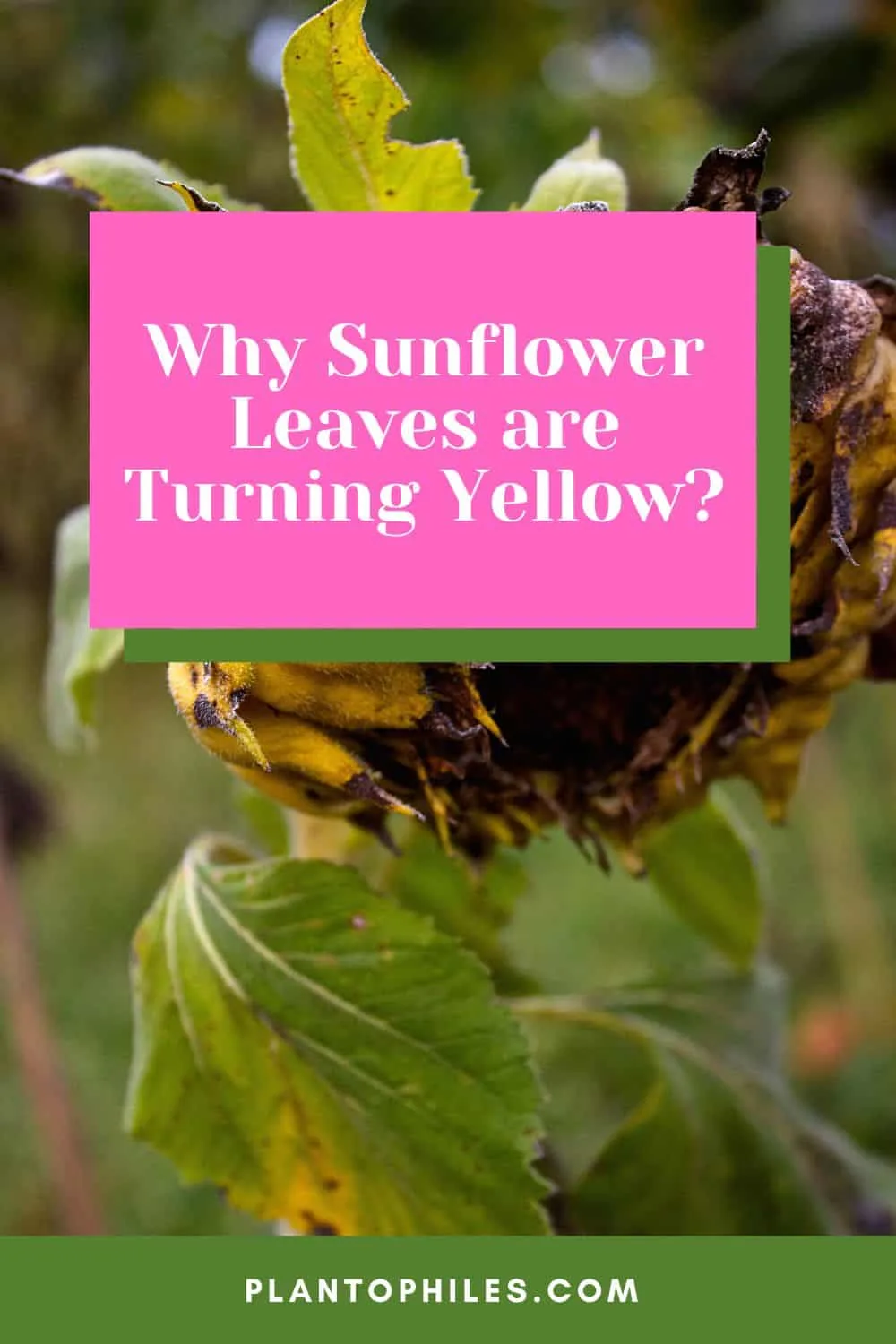
6 Common Reasons For Yellow Leaves on Sunflowers
1. Under or Over Fertilization
Sunflowers require a significant amount of nutrients. They grow quickly and often to a much larger size than most plants. They also need food to support this growth, like other living things.
Nitrogen, as well as phosphorus, are the most common deficiency for sunflowers. They also need potassium and micronutrients to thrive.
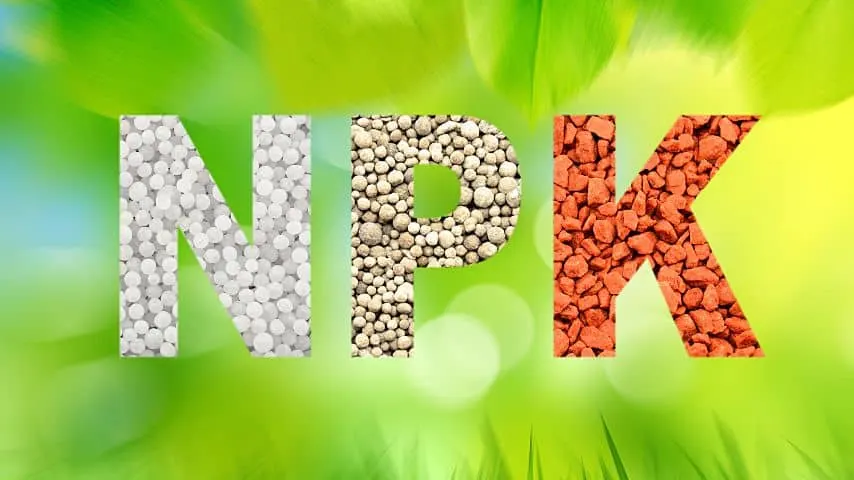
Yellow leaves that remain green close to the veins indicate that the plant is nitrogen deficient.
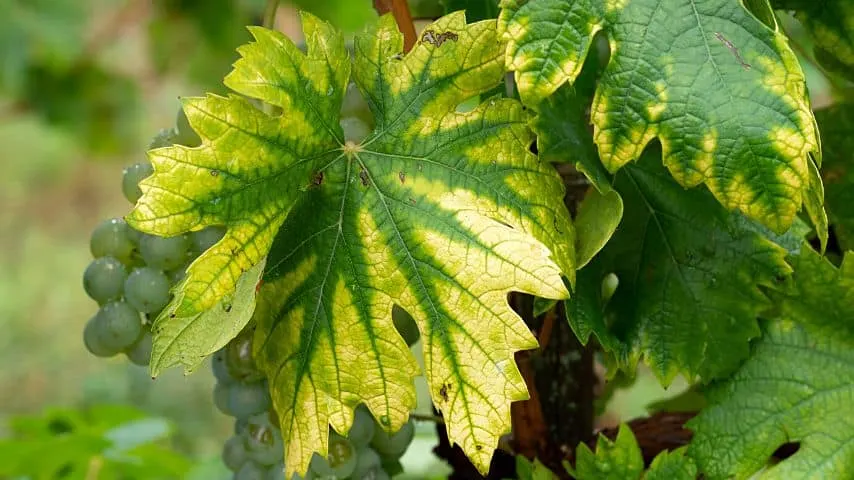
A phosphorus deficiency results in purple or reddish discoloration. It is essential to check on the stems and leaves frequently to spot common problems.
Deficiency in these nutrients will cause the leaves to turn yellow, particularly the lower or older leaves. Other signs include reduced growth and thin stems.
Of course, over-fertilization can also affect sunflowers. This can make the sunflower’s leaves wilt and turn yellow. You may also notice that the leaf margins and tips are turning brown, leaves are dropping, and growth has slowed or stopped.
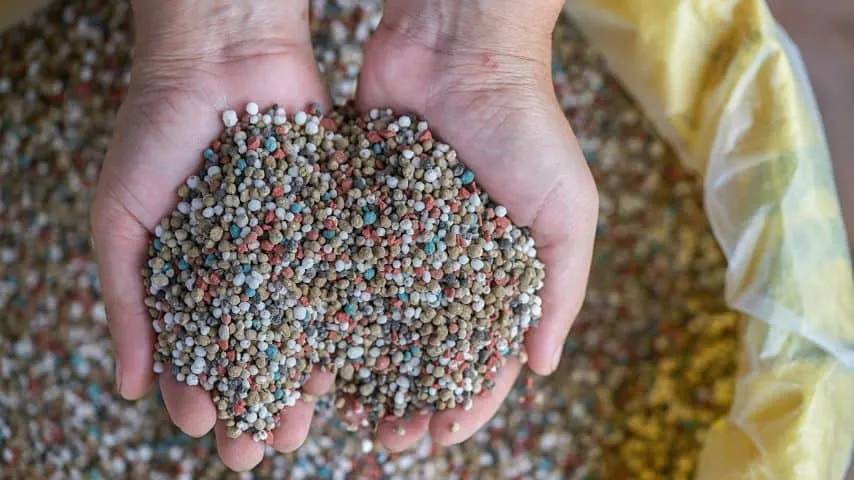
Proper Sunflower Fertilization
Ideally, the soil should be fertilized before sunflowers are planted. If it’s early in their growth cycle, a granular fertilizer can be used. Later in the season, use a water-soluble fertilizer for faster results.
A 10-10-10 fertilizer for garden plants works well. Follow the directions for the fertilizer.
When spotting these signs, use fertilizer and compost, and mulching to increase the number of nutrients. Especially nitrogen and phosphorus are vital for the growth of the plant.
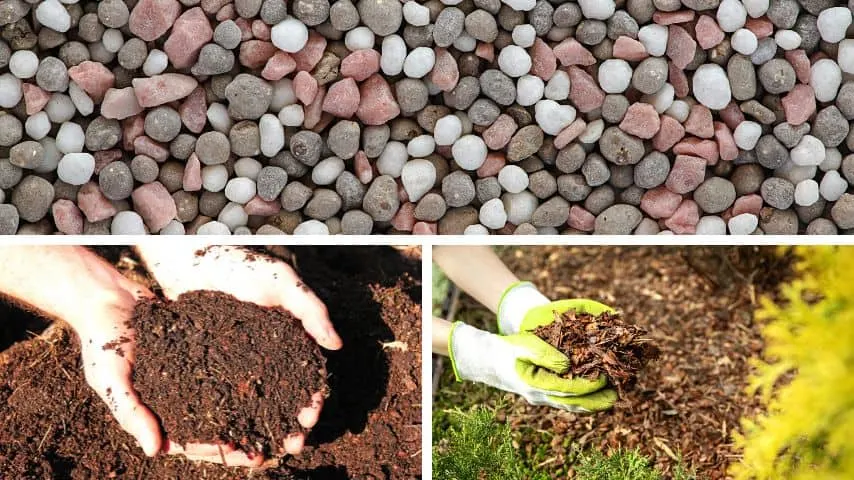
If you’ve over-fertilized your sunflowers, avoid further fertilization. Flushing the soil by saturating it with water can help. However, consistently soaking the soil will result in root rot.
If you are unsure if fertilization is the culprit, consider having the soil tested. This will eliminate the guesswork. You can then focus on the nutrients absent in your soil.
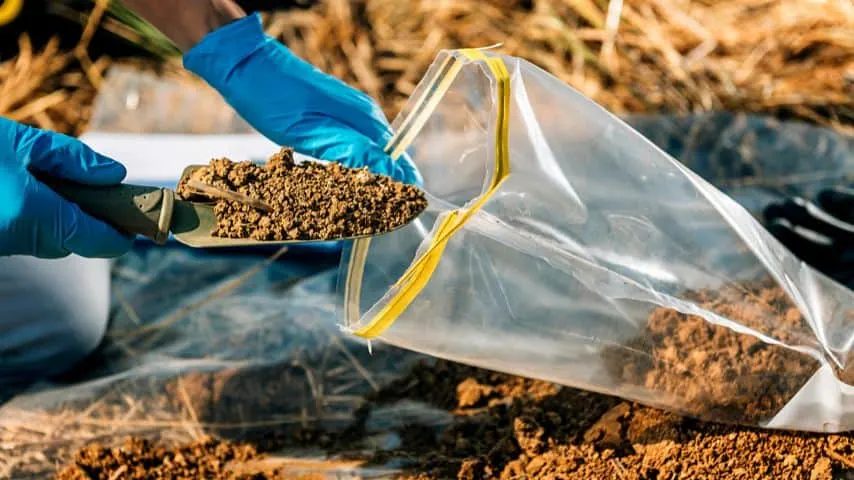
2. Overwatering
Plants need water to thrive. Generally, sunflower leaves turn yellow due to over-watering and poor drainage.
Soil too moist is a perfect breeding ground for fungus, which can cause root rot. This can occur if you are over-watering the sunflower directly.
It can also occur if the sunflower gets too much rain or the soil isn’t well drained.
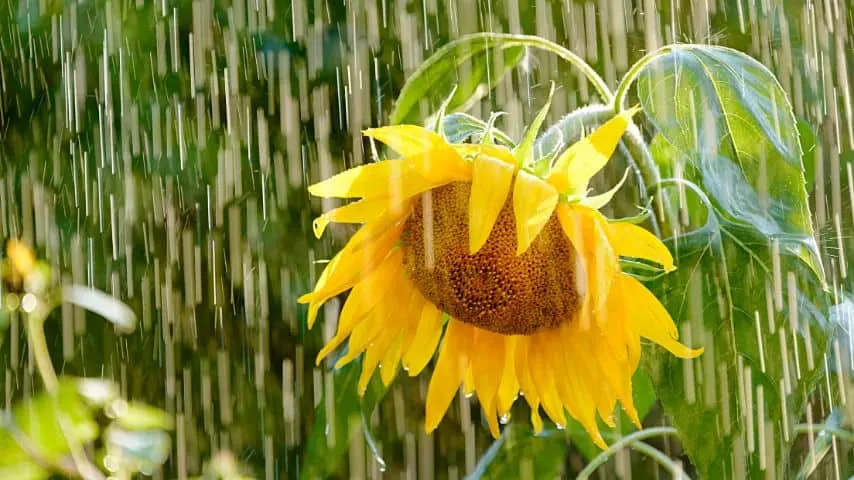
Overwatering will lead to wet soil, which allows fungal rot.
The fungus feeds on the plant’s roots. Since the roots are damaged, they can’t transport nutrients and water properly.
Even though sunflowers get a lot of water and you provide the correct amount of nutrients, discoloration follows.
Yellow leaves may appear, and the terms and leaves will wilt.
Proper Sunflower Watering
Sunflower soil should be moist but not soaked. The soil should never be completely dry.
Generally, sunflowers should be watered about twice a week. If the weather is very hot, they may need watering more often.
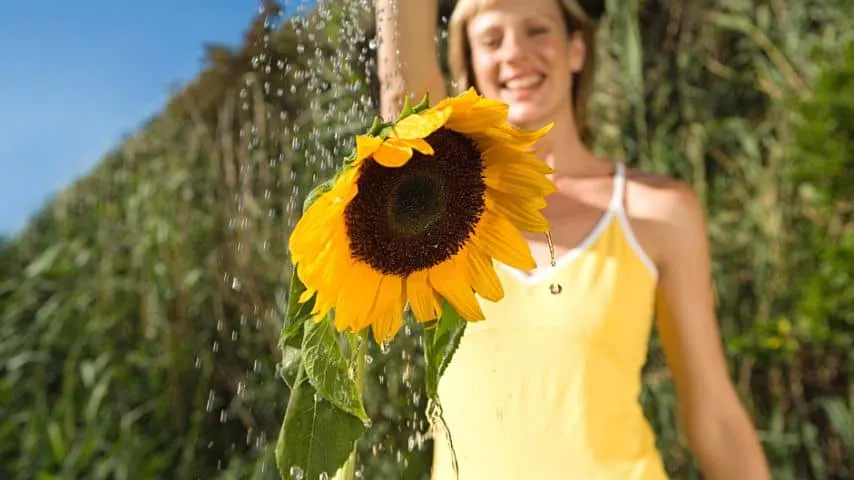
Water your sunflower if you find its soil is dry or its leaves are drooping. Sunflowers in the garden require about 2 gallons of water a week.
If your sunflower is in a pot, you’ll need to water it more often because it can’t search for water beneath the soil with its long roots.
Watering around the root zone is the way to go. Water the root zone until the soil is humid 2-3 inches down (4-7.5cm).
The right amount of water must be supplied to the base of the plant.
Potted plants need good drainage. Therefore use a pot with drainage holes. Overwatering can lead to root rot.
Moisture and nutrients ensure the sunflowers get the energy they need.
3. Too Much Heat or Sun
Sunflowers like warm sunny weather, as the name suggests. However, too much sunlight or extreme heat can harm them, which causes their leaves to turn yellow.
The plant prefers temperatures of 70 to 78 degrees Fahrenheit.
Research has shown that 44 degrees Fahrenheit is the lowest temperature sunflowers can tolerate.
They can tolerate hot temperatures as long as they have plenty of water.
However, if they receive more than 8 hours of direct sunlight, particularly along with very hot temperatures, the plant will begin to wilt.
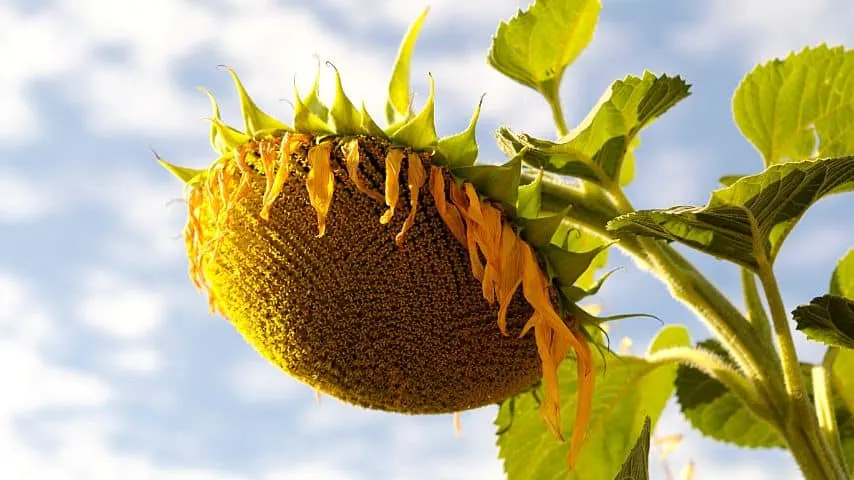
Ensure your sunflowers get direct sunlight for at least 6 hours daily.
The sun can damage the leaves, which causes them to turn yellow. If they continue to receive too much sun, the leaves may turn brown or black.
Reducing Sun Exposure
If your sunflower is in a pot, move it to a shadier area.
You may want to move it during the noon hours and allow it to receive the full morning and evening sun.
If your sunflower is in the ground, you can place a shade cloth or net over the plant. This is usually only needed during periods of extreme sun and heat.

4. Pests
Aphids and spider mites commonly feed on sunflowers. They feed on the sap from sunflowers, which causes nutritional deficiency because they steal the nutrients from the sunflower.
Aphids can cause yellow sunflower leaves, curling leaves, and stunted plant growth. They typically attack new growth. You may find small insects on the underside of the leaves.
Spider mites will cause spots on the leaves that are white or yellow and can eventually cause areas of the leaves to turn yellow. You may also see spider webs on the plant.
Getting Rid of Pests
Neem oil can help eradicate pests without harming the sunflowers as it is a natural pesticide.
Mix 1-2 tablespoons of the neem oil with a dish or insecticidal soap in 1 gallon of water. Then spray this mixture with a plant sprayer or spray bottle on the leaves.
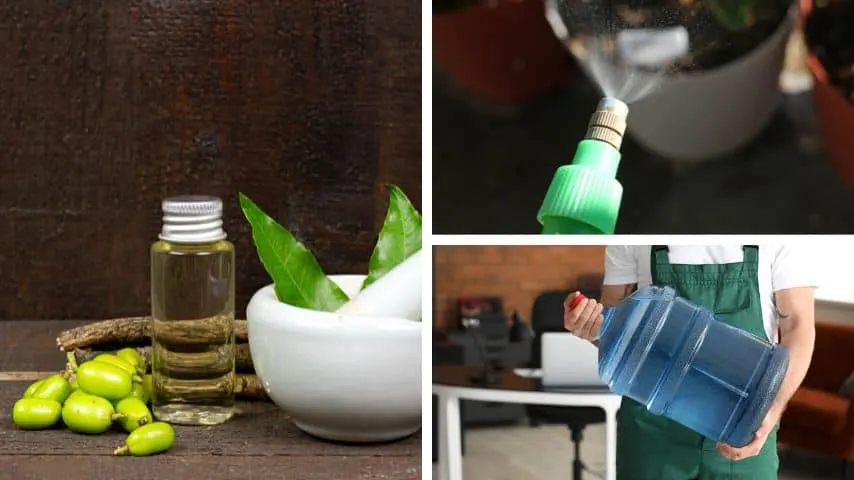
Make sure to pay attention to the leaves’ undersides and any areas where you find damage.
5. Fungal Diseases
Leaf yellowing is caused by a fungal infection called Alternaria leaf blight or Alternaria helianthi according to Plantvillage.
The plants develop brown and black lesions with a yellow halo around the edges. The yellow leaves may become blighted and will later fall off and die.
Fungal diseases leading to leaves turning yellow and brown should not be taken easily. The sunflowers might die.
Prune off the diseased leaves and ensure that the plants get sufficient airflow. Space them out when planting. This decreases the humidity around plants.

Sufficient Airflow
Research proves that air circulation around plants is vital. Airflow leads to thicker and healthier stems. The better the airflow, the taller and longer the sunflowers get.
Airflow is important around your sunflower.
Insufficient air circulation causes yellow leaves to appear and cause the sunflower to develop bacterial and fungal growth.
This is mostly caused by plants being planted too closely.
High humidity and temperatures, paired with insufficient airflow, lead to rot and fungus.
6. Natural Aging Process
If your sunflower’s head begins to droop, the leaves are likely yellowing because the flower is nearing the end of its life cycle.
You’ll also notice the sunflower’s petals turning brown during this time.
This process begins at about 13 to 15 weeks. At 15 to 17 weeks, the sunflower’s seeds will begin to drop.
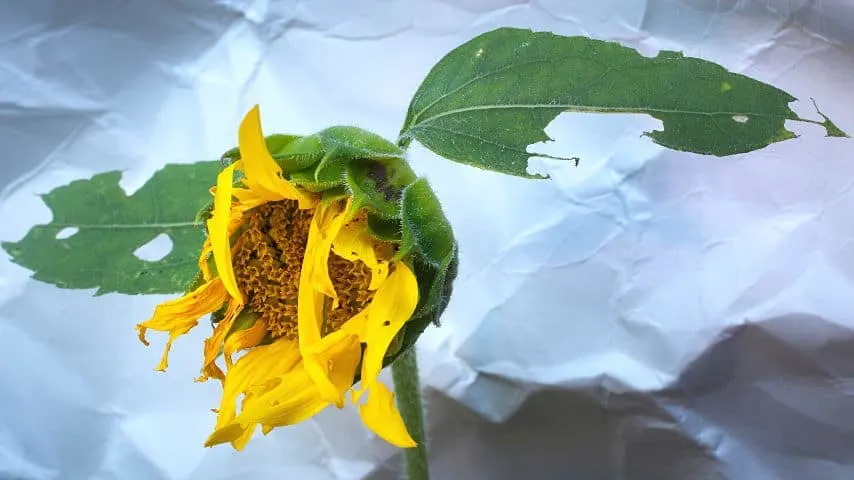
Frequently Asked Questions about Sunflower Leaves Turning Yellow
Should I remove the yellow leaves from my sunflower?
If the entire leaf is yellow, cut the leaf away with sterile scissors or a knife. If only part of the leaf is yellow, it shouldn’t be removed. Removing yellow leaves will tell the sunflower to focus on healthy leaves rather than diverting energy to damaged leaves.
Can a yellow leaf turn green again?
This depends on how extensive the leaf damage is. If the damage is mild, the leaf may repair itself. If only part of the leaf is yellow, remedying the problem may prevent the remaining leaf from turning yellow. This can save the leaf.
Final Thoughts On Yellowing Sunflower Leaves
If your sunflower leaves turn yellow, a lack of nutrients or too much water are the most common culprits. Too much heat or sunlight, or pests can also cause the yellowing of your sunflower’s leaves.

Daniel has been a plant enthusiast for over 20 years. He owns hundreds of houseplants and prepares for the chili growing seasons yearly with great anticipation. His favorite plants are plant species in the Araceae family, such as Monstera, Philodendron, and Anthurium. He also loves gardening and is growing hot peppers, tomatoes, and many more vegetables.


